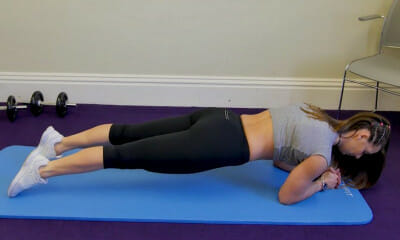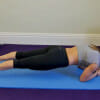How to Boost Your Health and Longevity?
Functional fitness is a kind of exercise designed to make your daily activities easier. That’s precisely what sets it apart from other exercise programs. It’s not about looking better or just getting stronger or faster, because what practical advantage are you going to get from that? Instead, it’s designed to make your daily life healthier and better.
Functional fitness training is relevant to many people simply because it doesn’t just focus on sports or exercise. It’s made for people who have lives that don’t revolve around fitness — and that’s most people. Better yet, functional fitness training also helps with your overall health and longevity.
If you’re someone who really needs to be better and stronger for certain different tasks ( i.e. grocery shopping), then practical fitness training is for you! Let’s look at how functional fitness training can improve your health.
How does functional fitness training work?
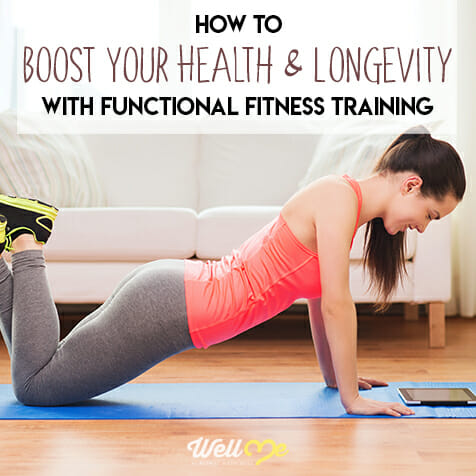
Functional fitness training is all about making your life easier. But what does that mean, exactly? Can an exercise program really make your everyday tasks easier? It’s rather tough to imagine, especially if a regular fitness program looks to you like going for a long run or lifting weights and “getting buff.”
The thing about functional fitness is that it is designed to be practical in a way that other exercise programs aren’t. While it still improves the basics that any fitness program would improve (flexibility, core strength, etc.) this isn’t the actual end goal. No, the end goal of functional fitness is to improve specific muscle groups used for particular tasks throughout your average day so that you can do them with greater ease and a lower risk of injury.
Functional fitness training is a program that can be done just about anywhere. Some people prefer to practice it at home, while others prefer to go to the gym. In that way, it is a lot like other fitness programs. You might even notice familiar exercises being done, such as squats, for example. That’s because the exercise must have a functional value to your everyday life. Think about it: what do you do in life that resembles a squat exercise? The muscle groups targeted by squats come in handy when you’re standing up from a chair or perhaps squatting down to get something from the floor.
Unlike training programs that are all about targeting one or two muscles at a time (strength training), functional fitness training targets all the muscles you would use in a specific activity. Strength or weight training of a traditional style does target whole groups of muscles, but it generally doesn’t help the different muscle groups work together — that’s what functional fitness training is all about.
Think about a specific exercise you’re doing. If you’re bending over to pick something up or to move something heavy, there is a ton of muscle work that goes into that motion. Your arms, shoulders, and back are all going to be used together in cooperation, so you have to use them all in your strength-building exercise.
What are the health benefits of functional fitness training?

So, now that you know the practical value of functional fitness training, you’re probably wondering how it will improve your health. To put it shortly, yes. Functional fitness training has the same long-term health benefits of other programs, and perhaps even better because it is not putting high amounts of strain on specific muscles that could eventually cause damage. Instead, it is focusing on multiple muscle groups at a time, allowing them to work together rather than being trained to work individually (which has very little practical value for most people).
We hear about random injuries all the time. Someone might throw out their back while transporting furniture during a move, or perhaps they mess up their ankle while bringing their dog out for a walk. We barely bat an eye when we hear about injuries like these, as if they are unavoidable and can just “happen.”
The truth is, however, that they can be avoided. Or, at least, the risk for getting a random injury like this can be greatly reduced with the help of functional fitness training. Functional fitness training is actually a type of resistance training, which makes it even better since it is low impact.
Muscle mass decreases by up to 50% between ages 30 and 80, and yet most adults aren’t doing regular strength training.
Functional fitness training is the kind of training regimen that can help everyone, but should be practiced by adults above the age of thirty. Unfortunately, only 6% of adults actually do regular (2-3 times per week) resistance training of some kind, even though we all lose a significant amount of muscle mass during adulthood.
Functional fitness training is especially beneficial for older adults, since they are more prone to accidents or injury. Sure, plenty of people bang their knee or head on something, and many of us even fall down once in a while. But this is, of course, a bigger problem for older people who could have some lasting health issues caused by one fall. While functional fitness training won’t make a person invincible, it will certainly help when it comes to lowering the risk of injury in the case of a small accident – it can also reduce the recovery time.
One of the most ignored aspects of muscle training in general is gaining flexibility. Flexibility is important for anyone’s physical health, and in a world of sitting at computers all day, most of us could benefit from being more flexible. It’s possible that flexibility can even help keep away illnesses like arthritis[1], for example. To put it simply, functional fitness training can help improve or ease joint pain, lower the chance of injury, improve your balance and posture, improve your flexibility and coordination, and even improves muscle memory. These things together make your life easier, safer, and potentially longer.
What are the strength benefits of functional fitness training?

One of the great things about functional fitness training is that it doesn’t target only one muscle, but almost always groups of muscles. While other strength training programs might use one muscle at a time, functional fitness training actually uses groups of muscle groups. In other words, it targets several at once so that you’re actively training them to work together rather than in isolation.
Some people who are avid gym-goers and do traditional weight training might scoff at how functional fitness training works. The truth is, however, that functional fitness training has been proven to be just as effective as conventional weight training in terms of improving functional ability in middle aged adults[2].
In another study of young adults conducted in 2010, participants were either assigned traditional training or functional fitness training exercises. These people were between the ages of 18 and 32, and they trained for 7 weeks before being tested for their strength and endurance abilities to see how they had improved. The study found that people doing traditional training gained more girth in certain muscles, while those in the functional fitness category gained more flexibility and girth in their shoulders.[3]
It’s essential to note that shoulder strength is extremely important, especially once adults reach their 70s. In fact, the stronger a person’s shoulders are, the stronger their upper body is. In other words, shoulder strength serves as an indicator of upper body strength in general.[4] While this might not convince some regulars at the gym, it should convince the “average” population to start doing functional fitness training. After all, just about everyone can benefit from it in some capacity.
Summary: What Should You Do Now?

So, now you’ve learned that functional fitness training benefits everyone in terms of their strength, health, longevity, and daily lives. After all this information about how functional fitness training can change your life for the better, you’re probably wondering how exactly to get started. Like any training program, you can start out simply and then gradually work your way up to doing more complicated things. But how can you start off right now?
To begin, there are some key areas in your body that can help with just about any exercise. These areas include the deep abdominals, the scapula stabilizers, and the hip abductors and rotators. If you don’t really know what those are, that’s completely fine! Let’s look at a few exercises to get started.
Action Steps: Try these functional fitness training exercises
- Pushup to arm and hip raise:
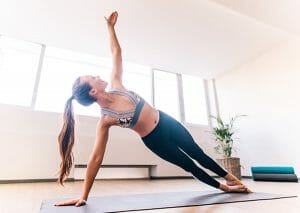
This works those foundational muscle groups: the scapula stabilizers, hip abductors and rotators, and the deep abdominals. But it also works out the pectoris major and minor, the rectus abdominus, and the obliques.
To do it, start with a regular pushup. Once your arms are straightened, lift one of your arms off the ground and rotate your body so your hand is pointed towards the sky and your body forms one flat plane. Now raise the leg that’s on top and hold it for around ten seconds. Now switch sides and do this at least five to ten times in order to get the most out of it. - Body weight squat:
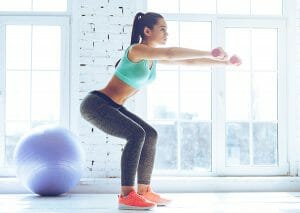
This exercise works the deep abdominals and hip abductors and rotators, but also the quadriceps, hamstrings, and glutes. You may have done this one before, as it can be found in many workout programs. Squats help with your core strength and leg strength, and they are ideal for someone whose daily activities include lifting, pulling, or pushing. The key here is to only use your own body weight rather than an additional weight of some kind.
Form is everything, since lazy squats aren’t going to help you improve. Put your feet shoulder-width apart, extend your arms out in front of you, and bend at your hips. When you squat down slowly, don’t allow your knees to go past your toes. Lower until your thighs are parallel to the floor, as if you’re sitting on a chair, and then slowly raise yourself back up and repeat. - Inverted row:
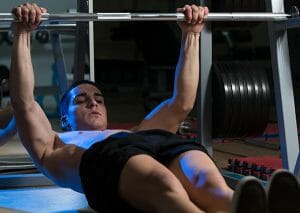
This is the perfect exercise for people who do anything related to pulling. That means even something simple like pulling to start a lawnmower. It works out the scapula stabilizers, the deep abdominals, the biceps, and the back muscles. You’ll need something above you to grab onto, such as straps or a bar.
Lie on your back and grab the object (i.e. the straps) above you. Use your arms to pull yourself up, leaving your legs extended on the floor and your upper body straight at all times. Once you’ve pulled your upper body up, squeeze the shoulder blades together, then lower yourself back down. - Exercise ball rollout:
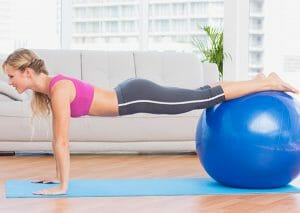
This works out your hip abductors, deep abdominals, scapula stabilizers (so all of the basic muscle groups mentioned), as well as the pectoralis major and minor, the deltoids, and the quadriceps. You will need an exercise ball in order to do it.
Start in an upper pushup position so your arms are extended and holding your body up. Then put your legs and feet on top of the exercise ball with your knees bent. Then extend them until they are straight, rolling the ball underneath them as you go. Hold your legs in the extended position for a few seconds, and then return them to a bent position. Do these ten times.
Those exercises are a great way to get started on your new functional fitness training routine. Be sure to add more as you feel necessary and look up the best exercises for the movements you do most in your life. After a few weeks or months, you’ll start to see a healthier, more flexible version of yourself.
Happy exercising!


















